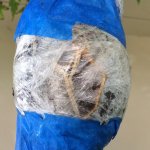RichKid
Shohin
Not looking so good there Rich... Might I make a suggestion? Spend the energy and time layering something with better movement. That is a telephone pole in the making... Unless you are layering it to grow it out, chop it, grow it some more... Which is tedious. Find a spot with a little wiggle to it and layer just below it.
Also- perlite. I am a broken record on this BECAUSE IT WORKS. Better than sphagnum.
Finally.. If you just put this on the end of May, you are only a little over 6 weeks into the layer- probably just needs more time. I had a few removed after about two moths this Spring, but that was the fastest I have ever had them take and the roots were a little young at the time of removal...
I layered that piece in particular because i actually did plan to make it a decades long project. Just clipping and growing. My main concern was getting that particular cultivar on its own roots with no graft unions. I was hoping that the mere sight of roots was enough to indicate success and that perhaps it just needed time. Now I'm not so sure! Most of the growth on that tree is straight. The top was beautiful and would've made a great tree but I tried to layer it last year and it died. Someone told me to layer from the bottom because basal branches have a better chance of throwing roots. So that's what I did. And it didn't die and even produced those little roots. Lol. I mixed perlite and sphagnum because I wanted something that would stay moist a little longer in case I wasn't able to get right to it. Do you think that perhaps this thing will grow roots if I leave it on till say Sept or is the current result indicative of a failure? Thanks for the advice.

